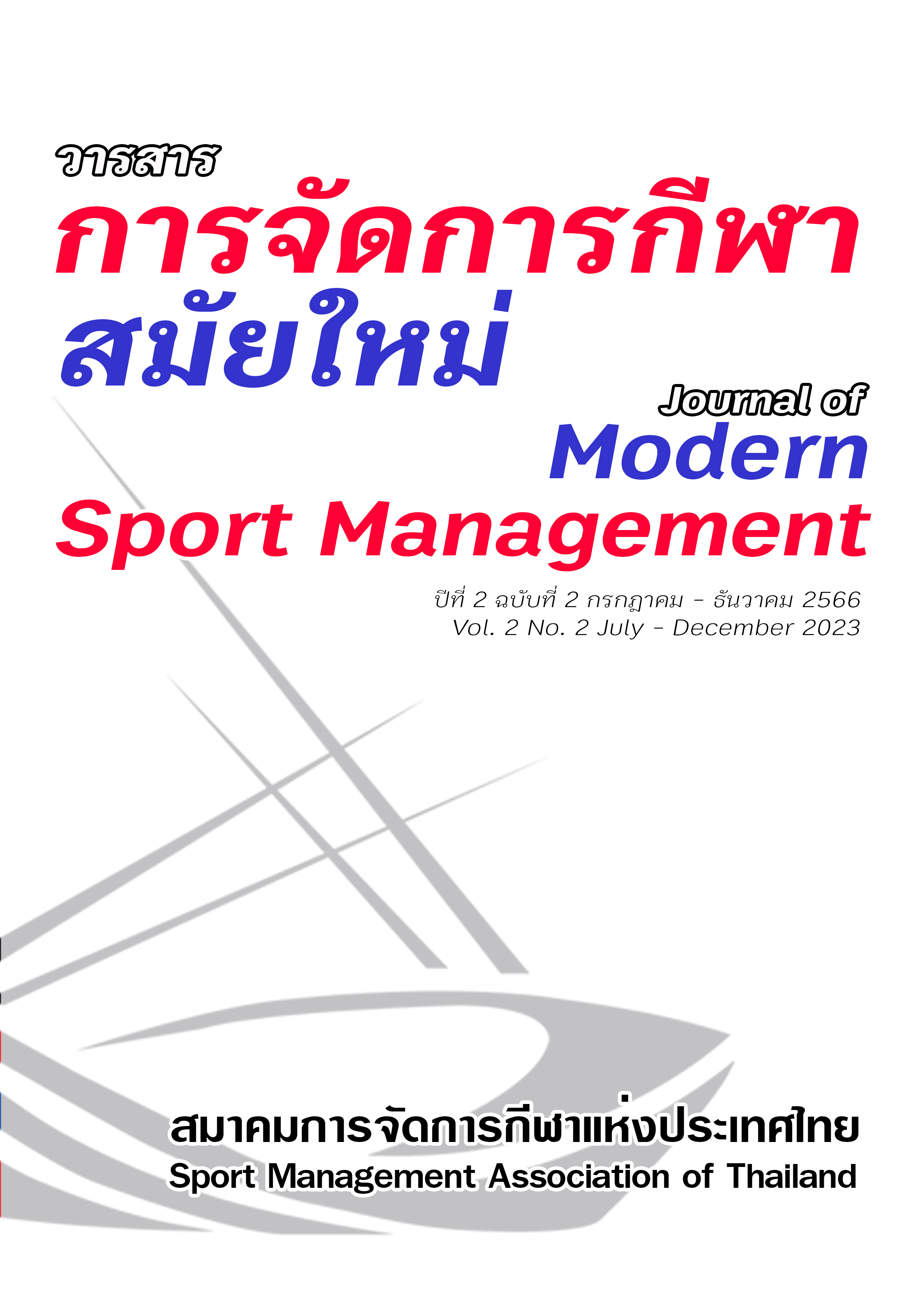หลักการที่สำคัญในกระบวนการพัฒนาองค์กรกีฬาสู่การเป็นองค์กรที่มีแนวคิดแบบลีน
Main Article Content
บทคัดย่อ
ในปัจจุบันมีความเข้าใจมากขึ้นถึงศักยภาพของการนำความคิดแบบลีน (Lean) ไปประยุกต์ใช้ในภาคส่วนต่างๆ ในหลายองค์กร ความตระหนักและความเข้าใจที่มากขึ้นได้กระตุ้นความสนใจมากยิ่งขึ้นในการที่จะนำแนวคิดแบบลีน ไปใช้ในการพัฒนาองค์กรกีฬา อย่างไรก็ตามยังไม่มีความชัดเจนว่าแนวคิดแบบลีน นั้นจำเป็นต้องมีกระบวนการแบบใดที่จะสามารถช่วยองค์กรกีฬาที่สนใจประยุกต์ใช้แนวคิดแบบลีน เนื่องจากแต่ละองค์กรกีฬาล้วนมีบริบทที่แตกต่างกัน บทความนี้ได้มีการทบทวนวรรณกรรมที่เกี่ยวข้องกับกรอบความคิดของวิธีการคิดแบบลีน (Lean Thinking) และองค์กรที่มีแนวคิดแบบลีน (Lean Thinking Organization) ซึ่งผู้เขียนได้พยายามอธิบายแนวคิดแบบลีน และองค์กรกีฬาที่มีแนวคิดแบบลีน นั้นควรจะเป็นเช่นไร รวมถึงอธิบายหลักการที่สำคัญและหัวใจของกระบวนการของแนวคิดลีน เหล่านี้เป็นสิ่งสำคัญต่อกระบวนการพัฒนาและการเปลี่ยนแปลงองค์กรกีฬาไปสู่การเป็นองค์กรกีฬาที่มีแนวคิดแบบลีน อีกทั้งข้อคำถามที่เกิดขึ้นพร้อมคำตอบที่ยังไม่ชัดเจนล้วนเป็นความท้าทายที่เกิดขึ้นจริงเมื่อมีการประยุกต์ใช้แนวความคิดแบบลีนต่อกระบวนการพัฒนาองค์กรกีฬาในปัจจุบัน
Article Details

อนุญาตภายใต้เงื่อนไข Creative Commons Attribution-NonCommercial-NoDerivatives 4.0 International License.
เอกสารอ้างอิง
Brandao, S. L. (2009). Trends and approaches in lean healthcare. Leadership in health services, 22(2), 121-139. http://dx.doi.org/10.1108/17511870910953788
Dickson, E. W., Anguelov, Z., & Vetterick, D. (2009). Use of lean in the emergency department: a case series of 4 hospitals. Annals of Emergency Medicine, 54, 504-510.
Ebert, C., Abrahamsson, A., & Oza, N. (2012). Lean software development. IEEE Software, 29(5), 22-25. https://doi.org/10.1109/MS.2012.116
Henriksen, K. (2015). Developing a high-performance culture: A sport psychology intervention from an ecological perspective in elite orienteering. Journal of Sport Psychology in Action, 6(3), 141-153. https://doi.org/10.1080/21520704.2015.1084961
King, D. L., Ben-Tovim, D. I., & Bassham, J. (2006). Redesigning emergency department patient flows: application of lean thinking to healthcare. Emergency Medicine Australasia, 18, 391-397.
Ohno, T. (2008). Workplace management. Portland, OR: Productivity Press.
Parent, M. M., & Hoye, R. (2018). The impact of governance principles on sport organisations’ governance practices and performance: A systematic review, Cogent Social Sciences, 4(1), 1-24. https://doi.org/10.1080/23311886.2018.1503578
Smith, J. (2022). Lean culture in sports organizations: Analyzing methods for cultivating a learning and improvement culture. Journal of Sports Management, 45(2), 123-136. https://www.journalsportsmanagement.com/lean-culture-in-sports-organizations
Tokatli, N. (2007). Global sourcing: insights from the global clothing industry—the case of Zara, a fast fashion retailer. Journal of Economic Geography, 8(1), 21-38.
Warrick, D. (2017). What leaders need to know about organizational culture. Business Horizons, 60(3), 395-404. https://doi.org/10.1016/j.bushor.2017.01.011
Womack, J. P., & Jones, D. T. (2003). Lean thinking: Banish waste and create wealth in your corporation. New York: Free Press.


